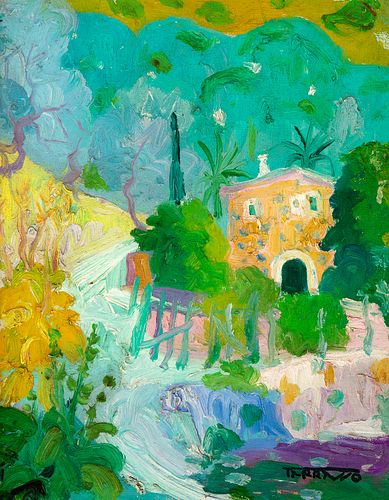CASIMIRO MARTÍNEZ TARRASSÓ (Sarrià, Barcelona, 1898 - Barcelona, 1980). "La caseta groga", Deyá. Oil on canvas. Signed in the lower right corner. Sign
Lot 45
About Seller
Setdart Auction House
Carrer Aragó 346
Barcelona
Spain
Setdart Subastas was born in 2004 and is currently the first online art auction in Spain with solidity, prestige and reliability guaranteed by our more than 60,000 users. Setdart has a young, dynamic and enterprising team ready to successfully manage the purchase and sale of art works through custom...Read more
Estimate:
$4,000 - $4,500
Absentee vs Live bid
Two ways to bid:
- Leave a max absentee bid and the platform will bid on your behalf up to your maximum bid during the live auction.
- Bid live during the auction and your bids will be submitted real-time to the auctioneer.
Bid Increments
| Price | Bid Increment |
|---|---|
| $0 | $10 |
| $200 | $25 |
| $500 | $50 |
| $1,000 | $100 |
| $3,000 | $200 |
| $5,000 | $500 |
| $10,000 | $1,000 |
| $20,000 | $2,000 |
| $50,000 | $5,000 |
About Auction
By Setdart Auction House
Jun 17, 2021
Set Reminder
2021-06-17 06:15:00
2021-06-17 06:15:00
America/New_York
Bidsquare
Bidsquare : 19th & 20th Century Contemporary Art - Select Lots
https://www.bidsquare.com/auctions/setdart-auction-house/19th-20th-century-contemporary-art---select-lots-7081
Setdart Auction House sofia@setdart.com
Setdart Auction House sofia@setdart.com
- Lot Description
CASIMIRO MARTÍNEZ TARRASSÓ (Sarrià, Barcelona, 1898 - Barcelona, 1980). "La caseta groga", Deyá. Oil on canvas. Signed in the lower right corner. Signed, titled and located on the back. Measurements: 41 x 33 cm; 62 x 54 cm (frame). Known simply as Tarrassó, he was formed in the School of La Lonja of Barcelona. He completed his studies in Paris, where he had first-hand knowledge of the Fauvist works that were shaking the Parisian artistic environment at the time. This Fauve influence will continue to be palpable in his work throughout his life in features such as the strong chromatic contrast, the high and somewhat exaggerated perspective, the absolute disinterest in the human figure, which appears only sketched as a complement to the landscape, and the representation of trees as electrified, subjected to tortuous inclinations. It is these formal features that give his works a vitality of their own and reduce his connection with the referential to a mere pretext. Tarrassó followed in the wake of the great Catalan landscape painters, focusing especially on Joaquín Mir, although with a clearly differentiated personality due in part to the impact that Fauvism had on his artistic thinking. He cultivated the still life and the Catalan and Majorcan landscapes. He held his first exhibition in 1928, at the Layetanas Galleries in Barcelona. Since then his exhibitions in Barcelona, Madrid, Palma de Mallorca and Bilbao followed one after the other. In 1935 he visited Mallorca for the first time, and from 1940 he had a studio there, specifically in Palma, where he lived for long periods and developed most of his artistic production. After the Civil War, during the forties, Tarrassó took part in several National Exhibitions of Fine Arts, in their editions of 1942, 1943 and 1950, and held many personal exhibitions in Barcelona, in galleries such as Augusta, Layetanas, Ars, etc., among them the one he held of Pyrenean landscapes in 1948, and the one of large canvases of Mallorcan landscapes that he presented in 1949. Although the landscape was always the center of his production, Tarrassó also made works such as the mural decoration of the church of Santa Maria de Badalona. In Mallorca he also carried out a singular undertaking, planting his easel in the Caves of Campanet to capture the stalactites and stalagmites of its stony cavities, developing a series of works that he presented at the Galerías Costa de Palma in October 1948. Throughout his career Tarrassó was awarded the Pollença Prize at the 1st International Painting Competition in 1962; the Santiago Rusiñol Prize in 1972; and the medals obtained in various editions of the Autumn Salons of Palma de Mallorca: first prize in 1967 and 1973, and honorary prize in 1970. Tarrassó's work is characterized by the great personality of his coloring. His obsession for chromatism determines a deeply sensorial, vitalist and intuitive painting. In many of his works, the painter focuses above all on capturing an image that stages the fullness of life recreated and without solution of continuity, worrying more about it than about the demands of the composition. His work is currently preserved in various national and international private collections, as well as in the Museum and Artistic Fund of Porreras (Mallorca) and the Museum of Modern and Contemporary Art of Palma.
- Shipping Info
-
In-house shipping available. Please inquire at admin@setdart.com.
-
- Buyer's Premium



 EUR
EUR CAD
CAD AUD
AUD GBP
GBP MXN
MXN HKD
HKD CNY
CNY MYR
MYR SEK
SEK SGD
SGD CHF
CHF THB
THB














